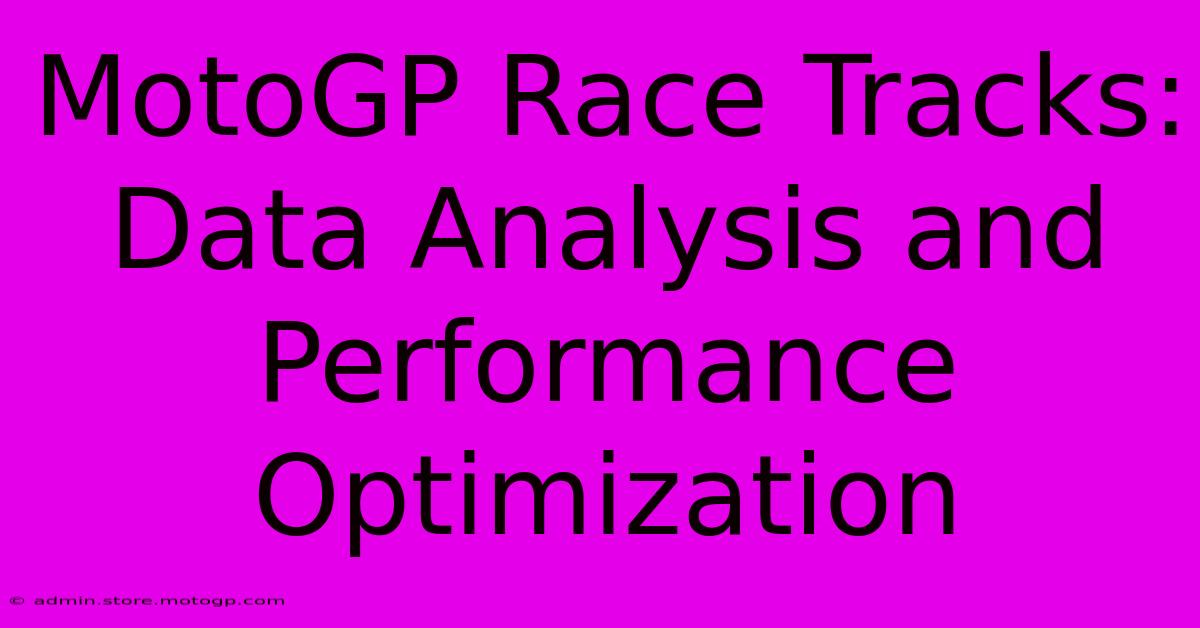MotoGP Race Tracks: Data Analysis And Performance Optimization

Table of Contents
MotoGP Race Tracks: Data Analysis and Performance Optimization
MotoGP racing, a pinnacle of motorcycle sport, demands meticulous planning and execution. Success isn't just about raw talent; it hinges on sophisticated data analysis and performance optimization across various aspects, including rider skill, bike setup, and crucially, understanding the unique characteristics of each race track. This article delves into the critical role of data analysis in maximizing performance across diverse MotoGP circuits.
Understanding the Track: A Data-Driven Approach
Each MotoGP track presents a unique challenge. From the fast, flowing corners of Assen to the demanding elevation changes of Austria's Red Bull Ring, understanding the track's intricacies is paramount. This understanding is built through extensive data collection and analysis.
Key Data Points for Analysis:
-
Track Map and Geometry: Detailed mapping, including corner radii, apex points, and track gradients, provides the foundational data. This informs braking points, acceleration zones, and optimal racing lines.
-
Lap Times and Sector Analysis: Analyzing lap times, sector times, and speed profiles reveals areas where a rider excels or struggles. Identifying these weaknesses and strengths is vital for targeted improvement.
-
Telemetry Data: This rich dataset, acquired through sensors on the bike, provides insights into throttle application, braking pressure, lean angles, and suspension performance at every point on the track. Analyzing this data helps fine-tune the bike's setup for maximum efficiency.
-
Weather Data: Weather conditions, including temperature, humidity, and wind speed, significantly affect track grip and bike performance. Analyzing historical weather data and real-time updates allows teams to make informed tire and setup choices.
Optimizing Performance: Data-Driven Strategies
Data analysis isn't just about understanding the past; it's about predicting and optimizing future performance. Teams utilize the collected data to refine various aspects of their race strategy.
Rider Performance Optimization:
- Identifying weaknesses: Data analysis highlights areas where a rider can improve their technique, such as braking points or corner entry speeds.
- Personalized training: Tailored training programs, based on data-driven insights, focus on addressing specific weaknesses and enhancing strengths.
- Simulation and virtual reality: Simulators allow riders to practice on virtual tracks, replicating real-world conditions and allowing them to experiment with different lines and techniques.
Bike Setup Optimization:
- Aerodynamic analysis: Wind tunnel testing and Computational Fluid Dynamics (CFD) simulations aid in optimizing the bike's aerodynamics for specific tracks.
- Suspension tuning: Telemetry data helps engineers fine-tune the suspension settings to maximize grip and stability in various sections of the track.
- Engine mapping: Optimizing engine mapping for specific track characteristics enhances acceleration and power delivery.
The Role of Technology in MotoGP Data Analysis
The sophistication of data analysis in MotoGP is constantly evolving, driven by advancements in technology.
- High-speed data acquisition: Advanced sensors and data logging systems capture vast amounts of data with high precision.
- Machine learning and AI: Artificial intelligence algorithms analyze large datasets to identify patterns and predict outcomes, enabling more accurate predictions and proactive adjustments.
- Cloud computing: Cloud-based platforms provide the necessary computing power and storage capacity to handle the massive datasets generated during races.
Conclusion: Data's Crucial Role in MotoGP Success
Data analysis is no longer a supplementary tool in MotoGP; it’s the cornerstone of success. By meticulously collecting, analyzing, and applying insights from diverse data sources, teams are able to optimize both rider performance and bike setup, ultimately leading to faster lap times and improved race results. The relentless pursuit of marginal gains, driven by sophisticated data analysis, defines the competitive landscape of MotoGP. The future of this exciting sport will undoubtedly see further integration of advanced analytics, pushing the boundaries of performance optimization even further.

Thank you for visiting our website wich cover about MotoGP Race Tracks: Data Analysis And Performance Optimization. We hope the information provided has been useful to you. Feel free to contact us if you have any questions or need further assistance. See you next time and dont miss to bookmark.
Featured Posts
-
Cota F1 General Admission On Any Budget
Feb 18, 2025
-
Inside The Machine Moto2 Bike Specifications Explained
Feb 18, 2025
-
F1 Austin 2025 A Must See Event
Feb 18, 2025
-
Malaysian Moto Gp The Ultimate Test Of Skill
Feb 18, 2025
-
The F1 Grid Formula A Beginners Guide To Starting Grids
Feb 18, 2025
